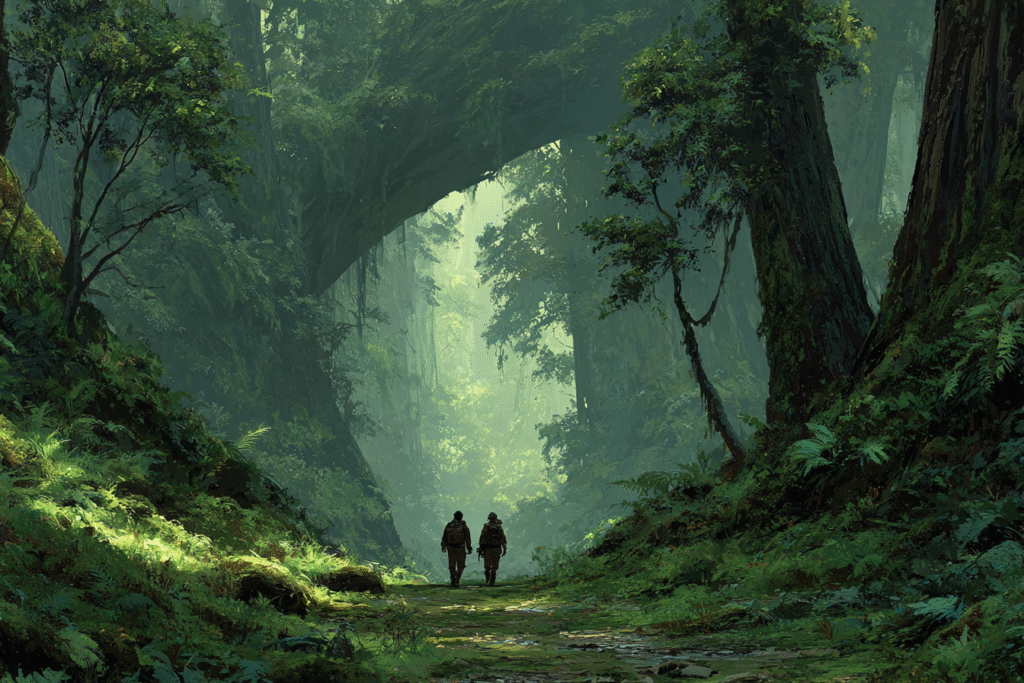
Let’s start with a confession: “mother trees” sounds like something dreamed up during a druid’s tea party, possibly while sipping pine-needle tea and listening to the whisper of the wind for plot ideas. Which, for the record, is not a terrible way to write.
I’ve been playing with the idea of sentient trees and magical forests for a long time. If you’ve read the Magorian and Jones series—or wandered into the wilds of The Scorched Lands Saga—you’ve already met forests that think, remember, and occasionally fight back. Trees in my worlds are not background scenery. They’re characters. Witnesses. Participants in the old, slow magic of the land.
But in my upcoming book, Roots of the Storm, I did something a little different. I borrowed directly from the real-world work of botanist and author Diana Beresford-Kroeger—specifically, her idea of “mother trees” that don’t just sustain the forest but can actually heal us. And the deeper I dug into the science, the more I realized I wasn’t writing fantasy. Not entirely.
What Are Mother Trees?
In the biological world, mother trees are the towering elders of the forest—often the oldest, largest trees—that serve as central hubs in the underground web of life. Through networks of mycorrhizal fungi (those thread-like structures that act like the forest’s internet), they send nutrients, chemical signals, and even warnings to surrounding trees.
This isn’t just tree-hugger mythology. Ecologist Suzanne Simard’s groundbreaking research showed that these elder trees can identify their own seedlings and preferentially share resources with them. That’s right—trees not only communicate, they recognize kin.
In Roots of the Storm, I took this concept and wove it directly into the story. My “mother tree” doesn’t just feed the forest—she touches the people who enter her domain. She offers healing, memory, and yes, a certain level of expectation in return. (She’s not running a charity, after all.)
Science Wearing a Leafy Cloak
I first stumbled across this intersection of science and magic thanks to Diana Beresford-Kroeger. If you haven’t read her books, go fix that. Seriously. You’ll emerge wanting to plant a tree, write it a poem, and possibly invite it over for tea.
Her work bridges hard science and deep ecological wisdom, revealing forests as intricate systems of communication and care. Trees, she explains, are not just passive oxygen factories—they’re intelligent, social beings. They share resources, protect each other, and actively shape the world around them. Some, like mother trees, even extend that influence to us.
Forest Bathing: Not Just for Elves
That idea—that forests can heal—is at the heart of Shinrin-yoku, or forest bathing. It’s a practice that originated in Japan, and it’s not about hiking or burning calories. It’s about being present in the forest, letting your senses soak in the living world around you.
The science is compelling: spending time in forest environments lowers cortisol (the stress hormone), reduces blood pressure, improves mood, and even boosts immune function. One reason? Phytoncides—aromatic compounds released by trees—appear to enhance our natural killer cell activity. The forest is literally helping your body defend itself.
And if that doesn’t feel like magic, I don’t know what does.
When Real Trees Feel Like Fantasy
This is where my two worlds meet: the imagined forests of fantasy and the very real woods we walk through on earth. They aren’t as far apart as we might think.
When you write fantasy, you’re always balancing wonder with something that feels real. And it turns out, ancient tree networks and forest healing aren’t speculative. They’re happening now. We’re only just beginning to understand what indigenous cultures and storytellers have known for centuries: the forest sees us. It remembers. And sometimes, it offers help.
So yes, in Roots of the Storm, the mother tree plays a central role—not just as a symbol of ancient power, but as a force of healing and memory. But she’s not a fairy tale invention. She’s based on the very real, awe-inspiring wisdom of the forest—and the scientists (and poets) who’ve helped us understand it.
Next time you’re walking through the woods, maybe pause. Say hello. There’s a good chance the trees are listening.
And if you want a little more of that magic in your life, Roots of the Storm will be arriving soon, tangled roots and all.

.
.
On pre-order: Firebird Omnibus
Newly Released: Sylvalight — Roots of the Storm — Magorian and Jones Series Boxed Set
Sentient trees work for me. If you listen they seem more than just an inanimate thing. I tend to think oceans and moving water have something too. They have such power and can bring so many strong feelings to me and so many people I know.
I will definitely check out that ecologists book and am looking forward to your upcoming book.
Yes, there’s something about them, isn’t there?
Taylen.
The Sapient Forest is also used to great effect in Michael Scott Rohan’s book “The Forge In The Forest”, second book in the saga of Elof the Magesmith that starts in “The Anvil of Ice”. The forest in question is the great forest Tapiau’La-An-Aithan. I don’t call it a “Mother Forest” because Tapiau is a most definite MALE personality. So, perhaps a “Father Forest?”
Interestingly, there is a real town called Tapiau, in the Kaliningrad region of Russia. It is just a coincidental name, there is no connection.
I also see a Yelp page for a restaurant called “The Forge in the Forest”, but I just discovered it has closed permanently earlier this year due to a new owner declining to renew their lease. The restaurant was a 50 year icon in Carmel, and many were upset that it closed. Here’s a link to an article, just for grins.
That’s such a shame, that a going concern like the restaurant would get shut down on the whim of the lease holder.
I sense that there’s a story behind the headlines that isn’t being shared. It’s a pity the journalst couldn’t talk to the lease holder, and report on that!
I’m checking out Rohan’s book!
Taylen.